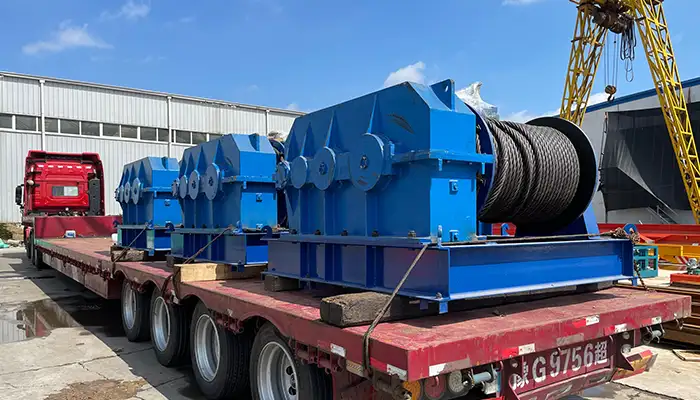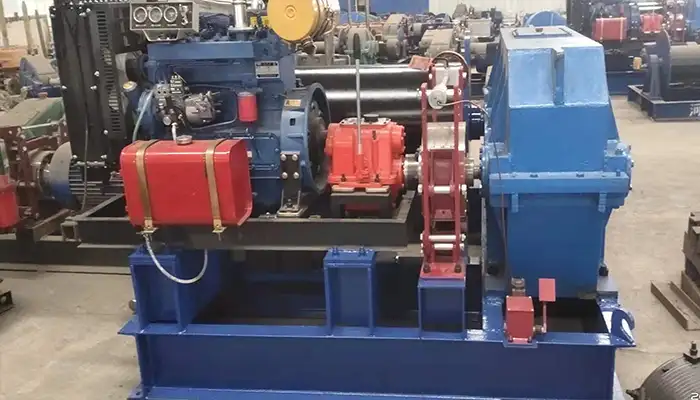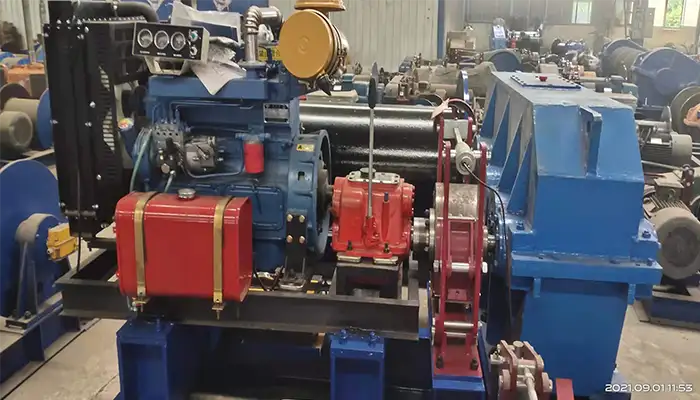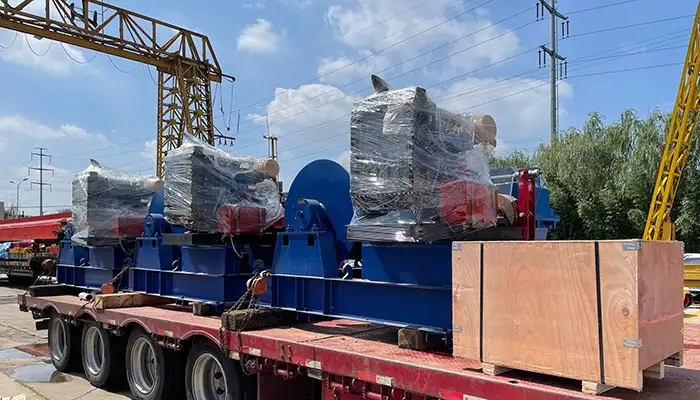20 Ton Diesel Winch for Sale Philippines - 3 Sets, A Case
20 Ton Diesel Winch for Sale Philippines - 3 Sets, A Case. Diesel winch for sale Philippines 20 ton capacity 100 m rope capacity. Get custom diesel winch for your needs from China, cost-effective pulling winch.
20 Ton Diesel Winch for Sale Philippines - 3 Sets: A Comprehensive Guide
The Philippines, with its diverse industrial landscape and challenging environments, requires robust and reliable machinery to handle heavy-duty tasks. Diesel winches, known for their power and durability, are indispensable in various sectors. This case study examines the use of 20 ton diesel winches in a project located in the Philippines, highlighting their applications, benefits, and practical considerations for buyers and users.
Diesel winches are essential tools in industries where heavy lifting and pulling are daily requirements. Their ability to operate independently of the electrical grid makes them particularly valuable in remote areas. This project involves the installation and operation of three 20 ton diesel winches at a construction site in the Philippines. These winches play a critical role in ensuring the project's success by efficiently handling heavy materials and equipment.
Project Information of 20 Ton Disel Winch
Background
The construction site for this project is located in a remote area of the Philippines, where access to electrical power is limited. The primary objective of using diesel winches is to lift and move heavy construction materials and equipment efficiently. The rugged terrain and challenging environmental conditions make diesel winches the ideal choice for this project.
Winch Type: Diesel Winch
Winch Capacity: 20 ton
Rope Capacity: 100 meters
Quantity: 3 units
Project Location: The Philippines
The diesel winches used in this project are designed to handle heavy loads with ease. Each winch features a high-torque diesel engine capable of pulling or lifting 20 tons. The 100-meter rope capacity allows for extensive reach, making it possible to handle materials from various points on the construction site. Additionally, these winches are equipped with advanced safety mechanisms, including automatic brakes and overload protection, ensuring safe and reliable operation.
Production of 20 Ton Diesel Winch
The production of a 20 ton diesel winch involves several meticulous steps to ensure high quality and performance:
- Design and Engineering: The design phase involves creating detailed specifications and blueprints. Engineers focus on optimizing the winch for strength, durability, and safety. Advanced software is used to model the winch and predict its performance under various conditions.
- Material Selection: High-quality materials are selected to ensure the winch can handle the heavy loads and harsh conditions. Components such as the drum, gears, and casing are made from durable metals like steel and aluminum alloys.
- Manufacturing Process: The manufacturing process involves precision machining, welding, and assembly. CNC machines are used to fabricate parts with high accuracy. Welding is performed by skilled technicians to ensure structural integrity.
- Quality Control: Throughout the manufacturing process, rigorous quality control measures are in place. Each component is inspected for defects, and the assembly process is monitored to maintain high standards.
Testing
Before the winches are delivered to the site, comprehensive testing is conducted to ensure they meet all performance and safety standards:
- Load Testing: The winches are subjected to load tests to verify their lifting capacity. This involves gradually increasing the load to the maximum rated capacity (20 tons) and observing the performance.
- Functional Testing: All functional aspects of the winch, including the drum rotation, brake system, and engine performance, are tested. This ensures that the winch operates smoothly and reliably under different conditions.
- Safety Testing: Safety mechanisms such as automatic brakes and overload protection are tested rigorously. This ensures that the winch can handle emergencies and prevent accidents.
- Environmental Testing: The winches are tested in simulated harsh conditions to ensure they can withstand extreme temperatures, humidity, and rough handling.
Delivery of 20 Ton Winch for Philippines
The delivery process is crucial to ensure the winches arrive at the project site in perfect condition:
- Packaging: The winches are securely packaged using protective materials to prevent damage during transportation. This includes using shock-absorbing materials and weather-resistant coverings.
- Transportation: Heavy-duty trucks and specialized transport vehicles are used to move the winches. Given the size and weight of the equipment, careful planning is required to ensure safe and efficient transportation.
- Customs Clearance: For international delivery, customs clearance is an important step. All necessary documentation is prepared, and the process is managed to avoid delays.
- On-Site Delivery: Once the winches arrive in the Philippines, they are transported to the project site. This involves coordinating with local logistics providers to navigate any geographical or infrastructural challenges.
Installation and Setup
The successful installation and setup of the 20 ton diesel winches are critical to ensure their reliable operation and longevity. Here’s a detailed look at each step involved in this process:
Transporting the Winches
Logistics Planning: Before transportation, detailed logistics planning is crucial. This involves selecting the right vehicles, routes, and schedules to ensure the winches arrive safely and on time.
Loading: The winches, given their size and weight, require heavy-duty trucks with adequate load capacity. Forklifts or cranes are used to load the winches onto the transport vehicles.
Securing the Load: The winches are securely fastened to the trucks using robust chains and straps to prevent movement during transit. Protective coverings are used to shield them from dust, moisture, and other environmental factors.
Transport Route: The route is planned to avoid low bridges, narrow roads, and other obstacles. Escorts or pilot vehicles may be used for added safety during transportation, especially for large or oversized loads.
Securing the Winches
Foundation Preparation: A stable and level foundation is prepared at the installation site. This is typically a concrete base that can support the weight and operational stresses of the winch.
Positioning the Winch: The winch is carefully positioned on the foundation using cranes or other lifting equipment. It is crucial to align the winch correctly with the operational area to ensure efficient load handling.
Mounting: The winch is anchored to the foundation using heavy-duty bolts and mounting plates. Vibration dampening pads may also be used to minimize operational vibrations and enhance stability.
Alignment: Precision tools are used to check and adjust the alignment of the winch to ensure that the drum and the rope are correctly oriented with the operational load direction.
Connecting the Ropes
Rope Selection: High-quality, durable ropes suitable for the winch’s capacity are selected. The rope length and type are chosen based on the specific application and operational requirements.
Threading the Rope: The rope is carefully threaded through the winch’s drum and guide mechanisms. Proper threading ensures smooth operation and prevents tangling or snagging.
Anchoring Points: The rope is anchored to the designated load points using secure and reliable fastenings such as shackles, hooks, or clamps. It is essential to ensure that all connections are tight and secure to handle the full load capacity.
Safety Checks
Inspection: A thorough inspection of all components is carried out to identify any potential issues or defects. This includes checking the winch drum, ropes, engine, and mounting bolts.
Functional Checks: All operational functions of the winch, such as the drum rotation, brake system, and engine controls, are tested to ensure they are working correctly.
Safety Mechanisms: The automatic brakes, overload protection, and emergency stop features are tested to confirm they are operational and effective.
Load Test: A preliminary load test is conducted with a partial load to ensure that the winch can handle the weight safely. This step verifies the overall integrity and performance of the installation.
Testing
Full Load Test: After the initial checks, the winch is subjected to a full load test, lifting and pulling the maximum rated capacity of 20 tons. This test confirms the winch’s ability to perform under actual working conditions.
Operational Testing: The winch is operated through its full range of functions, including lifting, lowering, and holding loads. This comprehensive testing ensures that the winch operates smoothly and efficiently.
Performance Monitoring: During testing, various performance parameters such as engine temperature, fuel consumption, and operational noise levels are monitored. Any anomalies are addressed before final commissioning.
Final Adjustments: Based on the test results, any necessary adjustments or fine-tuning are made to optimize the winch’s performance and ensure it meets all operational requirements.
By meticulously following these installation and setup steps, the diesel winches are prepared for reliable and safe operation. This thorough process ensures that the winches are ready to handle the demanding tasks required in the challenging environments of the Philippines.
Testing and Operational Use 20 Ton Diesel Winch
In daily operations, the diesel winches are used to lift and move heavy construction materials. Regular maintenance is crucial to keep the winches running smoothly. This includes checking oil levels, inspecting ropes for wear and tear, and ensuring all safety mechanisms are operational. Operators are trained on proper use and safety protocols to minimize risks and maximize efficiency.
Testing Procedures
Before the diesel winches are put into operational use, rigorous testing procedures are conducted to verify their performance and safety. These tests include:
- Load Testing: The winches undergo load testing to assess their lifting capacity and ensure they can handle the intended workload without strain or failure.
- Functional Testing: All components of the winches, including controls, brakes, and safety mechanisms, are thoroughly tested to verify their functionality and responsiveness.
- Environmental Testing: The winches are subjected to environmental conditions similar to those they will encounter in operational use, such as heat, humidity, and dust, to ensure they can withstand the rigors of real-world applications.
Operational Use
Once testing is complete and the winches are deemed ready for operation, they are deployed for a variety of tasks, including lifting and moving heavy construction materials. Key aspects of operational use include:
- Regular Maintenance: To ensure continued reliability and performance, regular maintenance is conducted on the winches. This includes checking oil levels, inspecting ropes for wear and tear, and ensuring all safety mechanisms are operational.
- Safety Protocols: Operators are trained on proper use and safety protocols to minimize risks and maximize efficiency. This includes adhering to load limits, using appropriate personal protective equipment, and following established procedures for winch operation.
- Efficiency Optimization: Operators strive to maximize efficiency in winch operation by carefully monitoring load levels, maintaining proper tension on ropes, and using winch controls with precision to ensure smooth and controlled movement of materials.
In the fast-paced world of industrial operations, the testing and operational use of 20-ton diesel winches are critical elements in ensuring project success and worker safety. Through rigorous testing procedures, regular maintenance practices, and adherence to safety protocols, these winches continue to prove their value as indispensable tools in driving progress and innovation across industries.
Applications of Diesel Winches in the Philippines
Diesel winches are versatile machines with a wide range of applications across various industries in the Philippines. Their power, durability, and independence from electrical power make them particularly valuable in the country’s diverse and often challenging environments. Here are detailed insights into their applications:
Construction
Lifting Heavy Materials: Diesel winches are essential in construction for lifting and positioning heavy materials such as steel beams, concrete blocks, and construction equipment. Their high lifting capacity ensures that large loads can be moved safely and efficiently.
Tower Crane Support: They can be used to assist tower cranes by pulling loads horizontally across the site, which is crucial for projects involving high-rise buildings or expansive construction areas.
Demolition: In demolition projects, diesel winches help in safely pulling down large structures by applying controlled force to strategic points.
Marine and Fishing
Anchoring: Diesel winches are used to anchor ships and boats securely, ensuring stability even in rough waters. Their ability to operate without relying on the ship’s electrical systems is a significant advantage in marine applications.
Towing: They are instrumental in towing smaller boats or fishing nets, which is a common requirement in both commercial and artisanal fishing.
Lifting Nets and Cages: In aquaculture, diesel winches assist in lifting heavy nets and fish cages out of the water for harvesting, cleaning, or relocation purposes.
Forestry
Skidding Logs: Diesel winches are used to drag felled logs from the forest to the roadside, where they can be loaded onto trucks. This is essential in logging operations, especially in remote areas without access to power.
Land Clearing: Winches help in clearing land by pulling out stumps, rocks, and other heavy obstacles, facilitating the preparation of land for replanting or construction.
Equipment Transport: They assist in moving heavy forestry equipment, such as chippers and grinders, across rugged terrain where vehicles cannot easily travel.
Mining
Hauling Equipment: In mining operations, diesel winches are used to haul heavy equipment and machinery into and out of mines, especially in underground mining where space is limited and electrical power may be unreliable.
Material Extraction: They play a critical role in extracting raw materials by pulling heavy ore-laden carts from deep within mines to the surface.
Safety Operations: Diesel winches are vital for emergency situations, such as rescuing trapped miners or stabilizing collapsed sections within a mine.
Agriculture
Moving Machinery: Diesel winches help in moving heavy agricultural machinery, such as tractors and plows, especially in areas where the ground is too soft or uneven for the equipment to operate independently.
Irrigation Systems: They are used to lift and position large irrigation systems or pipes, ensuring efficient water distribution across large farming areas.
Harvesting: In certain types of farming, diesel winches assist in the harvesting process by pulling harvesters or collecting large quantities of produce.
Infrastructure Development
Road Construction: Diesel winches support the construction of roads by pulling and positioning heavy equipment, laying down asphalt layers, and assisting in the placement of large structural components.
Bridge Building: In bridge construction, winches are used to lift and position heavy girders, cables, and other components, facilitating the assembly of complex structures.
Pipeline Installation: They play a crucial role in laying down pipelines for water, gas, and oil. The winches help in pulling the pipes into trenches and ensuring they are correctly aligned and secured.
Diesel winches are indispensable tools in many sectors in the Philippines. Their versatility, power, and ability to operate in remote and challenging environments make them an essential asset for numerous industries. By understanding their diverse applications, businesses and operators can better utilize these robust machines to improve efficiency, safety, and productivity in their respective fields.
Advantages of Diesel Winches
Diesel winches offer several key advantages that make them a preferred choice for many industrial applications, especially in challenging environments like those found in the Philippines. Here are the primary benefits:
High Torque
Powerful Lifting and Pulling: Diesel engines produce high torque at low RPMs, which is crucial for lifting and pulling heavy loads. This makes diesel winches exceptionally powerful and capable of handling the most demanding tasks.
Efficiency in Heavy-Duty Operations: The high torque output ensures that diesel winches can operate efficiently even under heavy loads, providing consistent performance without stalling or overheating.
Fuel Efficiency
Extended Operation Times: Diesel engines are known for their fuel efficiency, allowing winches to operate for longer periods without the need for frequent refueling. This is particularly beneficial in remote or continuous operation settings.
Cost-Effective: Lower fuel consumption translates to reduced operating costs, making diesel winches a cost-effective solution over the long term.
Durability
Rugged Design: Diesel winches are built to withstand harsh working conditions. They are constructed from high-quality materials that resist wear and tear, ensuring longevity.
Low Maintenance: Due to their robust construction and the inherent durability of diesel engines, these winches require less frequent maintenance, reducing downtime and operational interruptions.
Independence from Electrical Power
Remote Operation: One of the significant advantages of diesel winches is their ability to operate independently of the electrical grid. This makes them ideal for use in remote areas where electricity is unavailable or unreliable.
Versatility: The independence from electrical power allows diesel winches to be used in a variety of settings, from construction sites to off-shore platforms, without the need for electrical infrastructure.
Safety Features
Automatic Brakes: Modern diesel winches are equipped with automatic brake systems that engage immediately in case of power loss or emergency, preventing accidental load drops.
Overload Protection: Safety mechanisms include overload protection systems that stop the winch if the load exceeds its capacity, preventing damage to the winch and ensuring operator safety.
Emergency Stop Controls: These winches come with emergency stop controls that allow operators to halt operations immediately if a hazardous situation arises, enhancing overall safety on the job site.
Enhanced Stability: The robust construction and secure mounting options ensure that diesel winches remain stable during operation, minimizing the risk of accidents.
The advantages of diesel winches, including their high torque, fuel efficiency, durability, independence from electrical power, and advanced safety features, make them an indispensable tool in various industries. These benefits ensure that diesel winches provide reliable and efficient performance, even in the most challenging environments found in the Philippines. By choosing diesel winches, operators can achieve superior operational efficiency, cost savings, and enhanced safety in their heavy-duty tasks.
Challenges and Solutions
During the project, several challenges were encountered, such as transporting the heavy winches to a remote location and maintaining them in tough environmental conditions. These challenges were addressed through careful planning, regular inspections, and comprehensive training for operators. By ensuring all safety protocols were followed and the winches were properly maintained, the project was able to proceed smoothly.
Transportation Challenges
Heavy and Large Equipment: Transporting 20-ton diesel winches involves moving heavy and large equipment, which requires specialized transportation vehicles and careful planning.
Solution: Utilized heavy-duty trucks equipped with appropriate loading and securing mechanisms. Detailed logistics planning ensured that the route was free from obstacles and suitable for transporting oversized loads. Escort vehicles were used for added safety and compliance with local regulations.
Remote Location
Accessibility Issues: The project site was in a remote area with limited access to well-maintained roads and infrastructure.
Solution: Conducted a thorough site survey to identify the best routes and necessary improvements. Collaborated with local authorities and logistics companies to ensure smooth transportation. Temporary road improvements were made where necessary to facilitate access.
Environmental Conditions
Harsh Weather: The Philippines can experience extreme weather conditions, including heavy rains, high humidity, and heat, which can affect equipment performance and longevity.
Solution: Selected winches designed for durability and equipped with weather-resistant features. Regular maintenance schedules were established to inspect and protect the equipment against rust, corrosion, and other weather-related damage. Additional protective coverings were used during non-operational periods.
Maintenance and Operation
Frequent Maintenance Needs: Operating in tough conditions can increase wear and tear on the winches, necessitating regular maintenance to ensure reliability and safety.
Solution: Implemented a comprehensive maintenance program that included routine inspections, timely repairs, and replacement of worn-out parts. Used high-quality lubricants and maintenance materials to enhance performance and extend the lifespan of the winches.
Operator Training
Skill Requirements: Effective operation and maintenance of diesel winches require skilled operators who are knowledgeable about the equipment and safety protocols.
Solution: Provided extensive training for all operators, covering operational procedures, safety measures, and emergency response protocols. Ongoing training sessions were conducted to keep operators updated on best practices and new technologies.
Safety Protocols
Ensuring Safety: Handling heavy loads and operating powerful machinery pose significant safety risks.
Solution: Developed and enforced strict safety protocols to minimize risks. This included conducting safety drills, regular equipment inspections, and ensuring all operators and personnel were equipped with appropriate safety gear. Emergency stop mechanisms and overload protection systems on the winches further enhanced operational safety.
By addressing these challenges with strategic planning, robust solutions, and a commitment to safety and maintenance, the project was able to utilize the 20-ton diesel winches effectively. The careful attention to detail and proactive measures taken ensured that the winches performed reliably and safely, contributing to the successful completion of the project.
Conclusion
The deployment of three 20 ton diesel winches significantly improved the efficiency and safety of the construction project in the Philippines. These winches proved to be a reliable solution for heavy-duty lifting tasks, demonstrating their value in various industrial applications. Their ability to operate independently of the electrical grid and their robust design make them an ideal choice for projects in remote or challenging environments.




